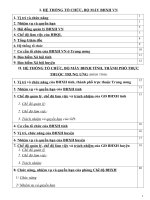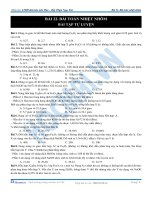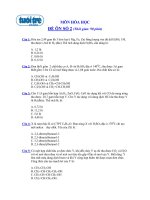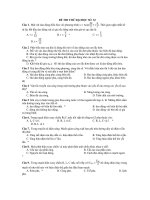PASSAGE 7
Bạn đang xem bản rút gọn của tài liệu. Xem và tải ngay bản đầy đủ của tài liệu tại đây (29.75 KB, 2 trang )
PASSAGE 7
A. Although speech is the most advanced form of communication, there are many ways of
communicating without using speech. Signals, signs, symbols, and gestures may be found in every known
culture. The basic function of a signal to impinge upon the environment in such a way that it attracts
attention, as, for example, the dots and dashes of a telegraph circuit. Coded to refer to speech, the
potential for communication is very great. Less adaptable to the codification of words, signs also contain
meaning in and of themselves. A stop sign or a barber pole conveys meaning quickly and conveniently..
Symbols are more difficult to describe than either signals or signs because of their intricate of relationship
with the receiver's cultural perceptions. In some cultures, applauding in a theatre provides performers
with an auditory symbol of approval. Gestures such as waving and handshaking also communicate certain
cultural messages.
B. Although signals, signs, symbols, and gestures are very useful, they do have a major
disadvantage. They usually do not allow ideas to be be shared without the sender being directly adjacent,
up the, receiver. An a result, means of communication intended to be used for long distances and extended
periods are based upon speech. Radio, television, and the telephone, are only a few.
Question 1. What does the author say about speech?
A. That is the only true form of communication
B. That is the most advanced form of communication.
C. That is necessary for communication to occur.
D. That is dependent upon the advances made by inventors
Question 2. According to the passage, what is a signal?
A. The most difficult form of communication.
B. A form of communication which may be used across long distances.
C. A form of communication that interrupts the environments.
D. The form of communication most related to cultural perceptions.
Question 3. Applauding was cited as an example of _________
A. a symbol
B. a sign
C. a signal
D. a gesture
Question 4. Why were the telephone, radio, and TV invented?
A. Because people were unable to understand signs, symbols, and signals.
B. Because people wanted new forms of entertainment.
C. Because people believed that signs, signals, and symbols were obsolete.
D. Because people wanted to communicate across long distances.
Question 5. It may be concluded from this passage that_________
A. symbols are very easy to define and interpret
B. only some cultures have signals, signs, and symbols
C. signals, signs, symbols and gestures are forms of communication
D. waving and handshaking are not related to culture
Page 1
ĐÁP ÁN
1-B
2-B
3-A
4-D
5-C
LỜI GIẢI CHI TIẾT
Question 1:
“Although speech is the most advanced form of communication,…”
Question 2:
“. Although signals, signs, symbols, and gestures are very useful, they do have a major disadvantage…..
An a result, means of communication intended to be used for long distances…”
Question 3:
“In some cultures, applauding in a theatre provides performers with an auditory symbol of approval.”
Question 4:
“An a result, means of communication intended to be used for long distances and extended periods are
based upon speech. Radio, television, and the telephone, are only a few.”
Question 5:
“Although speech is the most advanced form of communication, there are many ways of communicating
without using speech. Signals, signs, symbols, and gestures may be found in every known culture.”, “
Page 2









